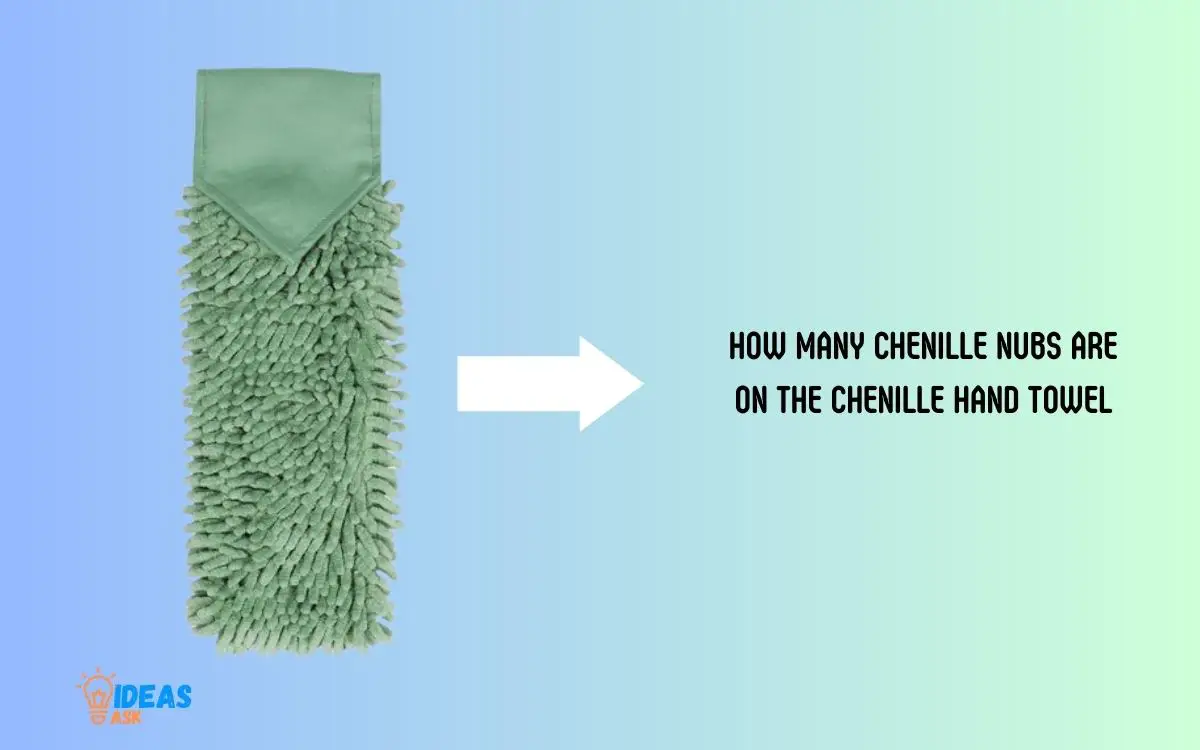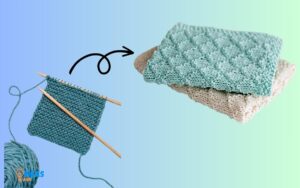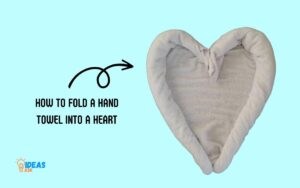How Many Chenille Nubs Are on the Chenille Hand Towel?
The number of chenille nubs on the chenille hand towel can vary depending on the size and design of the towel, but on average, there are approximately 1,500 to 2,000 nubs.
A chenille hand towel is a type of towel made from chenille, a fabric characterized by its ‘nubby’ texture which is created through the use of short lengths of yarn called “chenille nubs”.
These nubs are what give the towel its soft and plush feel. The number of nubs can vary significantly based on the size of the towel and the density of the nubs. Typically, smaller towels will have fewer nubs than larger ones.
When purchasing a chenille hand towel, one of the unique features to consider is the number of chenille nubs. These nubs directly influence the softness, plushness, and absorbency of the towel.
On average, a standard-sized hand towel may have between 1,500 to 2,000 nubs, making it an ideal option for those who prefer a luxurious, spa-like feel in their bathroom linen.

Key Takeaway
The Importance Of Chenille Nubs On Hand Towels
Chenille hand towels boast a significant number of plush chenille nubs, providing optimal absorbency and softness. These nubs enhance the towel’s effectiveness in drying hands quickly and efficiently.
Chenille Hand Towels And Their Unique Texture
When it comes to choosing the perfect hand towel, there are numerous factors to consider. One particular type of hand towel that has gained popularity is the chenille hand towel. These towels are known for their unique texture, which is both luxurious and functional.
But what exactly is it about the chenille nubs on these towels that make them so special? Let’s dive in and explore the importance of chenille nubs on hand towels.
The presence of chenille nubs on hand towels serves a crucial purpose.
Here’s why they are important:
- Enhanced Absorbency: The chenille nubs act as tiny sponges, increasing the towel’s absorbency. By design, these nubs effectively soak up moisture, allowing you to dry your hands more efficiently.
- Soft and Gentle: The chenille nubs provide a soft and gentle feel against your skin when drying your hands. They create a soothing sensation while effectively removing any moisture.
- Exfoliation and Massage: The texture of the chenille nubs provides a gentle exfoliating effect as you dry your hands. They help to remove dead skin cells, leaving your hands feeling refreshed and rejuvenated. Additionally, the massaging action of the nubs can help stimulate blood flow and promote relaxation.
- Increased Durability: The chenille nubs on hand towels enhance their durability. These nubs are securely woven into the fabric, making the towel more resistant to wear and tear. With proper care, chenille hand towels can maintain their plush texture and functionality for a long time.
- Aesthetically Pleasing: Apart from their practical benefits, the arrangement of chenille nubs on the hand towels creates an appealing visual texture. The nubs can add a touch of elegance and sophistication to your bathroom decor.
So, when choosing a hand towel, consider the chenille nubs and the benefits they bring. Their absorbency, softness, exfoliating properties, durability, and aesthetic appeal make chenille hand towels an excellent choice for any bathroom.
Upgrade your hand towel collection with these luxurious and functional towels today!
Exploring The Construction Of Chenille Hand Towels
Constructed with meticulous attention to detail, Chenille Hand Towels feature an impressive array of nubs, adding both style and functionality.
Experience the luxury of countless Chenille nubs, designed to provide enhanced absorbency and a plush texture for ultimate comfort.
Chenille hand towels are renowned for their softness, absorbency, and luxurious feel. But have you ever wondered how these towels are made?
The Process Of Creating Chenille Fabric
Chenille fabric is created through a unique manufacturing process that involves several steps.
Here’s a breakdown of how chenille hand towels are made:
- Yarn selection: The process begins with selecting high-quality yarn, typically made from cotton or synthetic fibers. The yarn chosen plays a significant role in determining the final texture and durability of the chenille towel.
- Weaving the base fabric: The selected yarn is woven together to create a base fabric for the towel. This fabric serves as the foundation onto which the chenille nubs will be attached. The weaving process can be done using various techniques, including plain weave or twill weave.
- Cutting the chenille pile: Once the base fabric is ready, the next step involves cutting yarn into smaller pieces to form the chenille pile. These cut yarn pieces are often referred to as “chenille nubs” and are what give the towels their unique appearance and soft texture.
- Attaching the chenille pile: The cut chenille yarn is then attached to the base fabric, secured by a binding thread. This process can be done either by hand or through the use of specialized machinery. The density and arrangement of the chenille nubs can vary, depending on the desired design and functionality of the hand towel.
- Finishing touches: Once the chenille pile has been attached, the towel goes through various finishing processes, such as washing, dyeing, and drying. These processes help enhance the overall quality and appearance of the towel, ensuring its softness and color vibrancy.
Factors Affecting The Number Of Chenille Nubs
The number of chenille nubs on a hand towel can vary based on several factors.
Here are a few key factors that influence the quantity of chenille nubs:
- Yarn thickness: The thickness of the yarn used in the construction of chenille hand towels can impact the number of chenille nubs. Thicker yarn strands tend to create larger and fewer nubs, while thinner yarn strands result in smaller and more abundant nubs.
- Pile height: The length of the chenille nubs, also known as pile height, can influence their total count. Higher pile heights generally lead to a lower number of nubs, as the yarn is spread out over a larger surface area. Conversely, shorter pile heights tend to result in a higher density of chenille nubs.
- Density of attachment: The density at which the chenille yarn is attached to the base fabric affects the overall number of nubs. Higher densities of attachment lead to a greater number of chenille nubs, while lower densities result in fewer nubs.
- Design preferences: The desired design and aesthetic of the hand towel can also impact the number of chenille nubs. Some designs may call for a dense arrangement of nubs, while others might opt for a sparser distribution.
Understanding the construction process and the factors that influence the number of chenille nubs provides valuable insight into the quality and characteristics of chenille hand towels.
This knowledge not only enhances your appreciation for these luxurious towels but also helps you make an informed choice when selecting the perfect chenille hand towel for your needs.
A Look At The Chenille Nub Count
The Chenille Hand Towel boasts a high Chenille Nub Count, providing superior absorbency and softness. Experience the luxury of countless nubs on this premium hand towel.
Understanding The Concept Of Chenille Nub Count
Chenille hand towels are known for their softness and unique texture, which is created by the chenille nubs on the surface. The chenille nub count refers to the total number of these nubs present on a hand towel.
Understanding the concept of chenille nub count is essential for those looking for the perfect hand towel that meets their preferences.
Let’s take a closer look at what factors influence the number of chenille nubs on a hand towel and how it can impact your experience.
Factors Influencing The Number Of Chenille Nubs On A Hand Towel
When it comes to the number of chenille nubs on a hand towel, several factors come into play. These factors determine the density and overall feel of the towel, making it crucial to consider when making a purchase.
Here are the key factors that influence the chenille nub count:
- Yarn Thickness: The thickness of the yarn used to create the chenille nubs can influence the overall number of nubs on the towel. Thicker yarns tend to create a higher density of chenille nubs, resulting in a more plush and luxurious feel.
- Weaving Technique: The weaving technique employed during the manufacturing process also affects the chenille nub count. Different techniques can produce varying densities of chenille nubs, impacting the softness and absorbency of the hand towel.
- Towel Size: The size of the hand towel plays a role in determining the chenille nub count. A larger towel may have more surface area, allowing for a higher nub count, while a smaller towel may have a denser arrangement of chenille nubs.
- Quality of Material: The quality of the material used in the hand towel can affect the chenille nub count. Higher quality materials tend to have better yarn consistency, resulting in a more even distribution of chenille nubs.
- Manufacturing Standards: The standards followed during the manufacturing process can also impact the chenille nub count. Hand towels produced under strict quality control measures are more likely to have a consistent, desirable density of chenille nubs.
When considering the number of chenille nubs on a hand towel, it’s important to find the right balance that suits your personal preferences.
While a higher chenille nub count can provide a softer and more luxurious feel, it may also affect drying time and durability.
On the other hand, a lower chenille nub count can offer quicker drying but potentially sacrifice some of the plushness.
By understanding these factors, you can make an informed decision and find a hand towel with the ideal chenille nub count for your needs.
Remember, choosing a hand towel with the perfect chenille nub count is a subjective experience.
It may require some trial and error to find the towel that offers the desired balance of softness, absorbency, and durability. So take the time to explore different options and prioritize what matters most to you.
Determining The Ideal Chenille Nub Count
The ideal chenille nub count for a chenille hand towel depends on personal preference and desired level of absorbency.
With various options available, choosing the right amount of nubs ensures maximum comfort and functionality. Explore different counts to find the perfect balance for your needs.
Have you ever wondered how many chenille nubs are on a chenille hand towel? The answer to this seemingly simple question actually plays a crucial role in determining the overall quality and performance of the towel.
Evaluating The Desired Level Of Absorbency:
- Density of nubs: The more chenille nubs a hand towel has, the higher its absorbency potential. A higher density of nubs means more surface area to capture moisture and ensure effective drying.
- Sufficient spacing: While a dense arrangement of chenille nubs is desirable for absorbency, it’s equally important to have adequate spacing between the nubs. This allows the towel to effectively release moisture when wrung out, preventing the formation of damp patches that can hinder further absorption.
- Suitable nub height: Optimal absorbency also depends on the height of the chenille nubs. Nubs that are too short may not provide enough surface area to effectively soak up moisture, while overly long nubs can become weighed down and less efficient. Striking the right balance is crucial for maximum absorbency.
Considering The Visual And Tactile Appeal:
- Plushness: The number of chenille nubs contributes to the plushness of the towel. A higher count of nubs creates a more luxurious and soft texture, enhancing the overall user experience.
- Uniformity: While the nub count is a factor to consider, maintaining a uniform distribution of nubs across the towel is equally important. A visually pleasing and consistent appearance ensures that the towel delivers the desired aesthetic appeal.
- Resistance to shedding: Too few chenille nubs can lead to shedding or unraveling of the towel over time. The ideal nub count should offer durability and resistance to shedding, ensuring the towel remains intact even with repeated use and washing.
Determining the ideal chenille nub count for a hand towel involves evaluating both absorbency and visual/tactile appeal.
By striking the right balance between a sufficient number of chenille nubs and their height, spacing, and distribution, you can ensure a towel that delivers optimal performance while providing a plush, visually appealing experience.
Best Practices For Chenille Nub Maintenance
The Chenille hand towel boasts a multitude of soft nubs, creating a luxurious feel and effective drying capability. Discover how the towel’s intricate design and superior craftsmanship ensure optimal comfort and durability.
Tips On Washing And Care To Preserve Chenille Nubs
Taking proper care of your chenille hand towel is essential to preserve the beauty and longevity of its chenille nubs.
Here are some best practices to consider when washing and caring for your chenille hand towel:
- Minimize the use of harsh detergents: To prevent damage to the chenille nubs, opt for a mild detergent that is gentle on fabrics.
- Wash in cold water: Hot water can cause the chenille nubs to become weak and more prone to shedding. Always choose cold water for washing your chenille hand towel.
- Use a gentle cycle: When laundering your towel, select a gentle or delicate cycle on your washing machine. This will help maintain the integrity of the chenille nubs.
- Avoid bleach and fabric softeners: These products can damage the chenille fibers and make them lose their softness and nub-like texture. Steer clear of bleach and fabric softeners when washing your chenille hand towel.
- Air dry or tumble dry on low heat: After washing your towel, air drying is the best method to maintain the chenille nubs. If you prefer using a dryer, opt for a low heat setting to prevent any potential shrinkage or damage to the nubs.
Ways To Prevent Friction Or Shedding Of Chenille Nubs
To keep your chenille hand towel looking its best and prevent any friction or shedding of the chenille nubs, consider the following tips:
- Wash separately: To avoid friction and potential damage to the chenille nubs, wash your chenille hand towel separately from other items, especially those with velcro or zippers that could snag the delicate fibers.
- Avoid harsh surfaces: Chenille nubs are delicate and can easily snag on rough or abrasive surfaces. Avoid rubbing or scrubbing your towel against hard surfaces, as this can lead to shedding of the chenille nubs.
- Handle with care: When drying your hands or using the towel, be gentle with the chenille nubs. Avoid tugging or pulling on them, as this can loosen or dislodge the nubs.
- Store properly: When not in use, fold your chenille hand towel neatly to minimize any friction between the chenille nubs. Store it in a dry and well-ventilated area to prevent moisture build-up that could weaken the nubs over time.
By following these best practices for chenille nub maintenance, you can ensure that your chenille hand towel remains soft, plush, and visually appealing for a longer period of time.
Conclusion
The number of chenille nubs on a chenille hand towel may vary depending on the brand and size of the towel. However, it is important to know that the quantity of chenille nubs does not necessarily determine the quality or effectiveness of the towel.
The true measure of a chenille hand towel’s performance lies in its absorbency, softness, and durability.
When considering a chenille hand towel, it is essential to focus on the material used, such as the quality of the chenille fabric and the construction of the towel. These factors play a more significant role in determining the towel’s overall performance and longevity.
For consumers seeking a luxuriously soft and absorbent chenille hand towel, it is recommended to choose a reputable brand known for their attention to detail and commitment to providing high-quality products.
By prioritizing factors like fabric quality, construction, and customer reviews, you can ensure that the chenille hand towel you select will meet your expectations for both comfort and functionality.
Remember, it’s not just about the number of chenille nubs, but the overall quality that will make your chenille hand towel a standout addition to your bathroom or kitchen.
Choose wisely and enjoy the plush comfort of a high-quality chenille hand towel.






